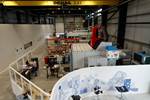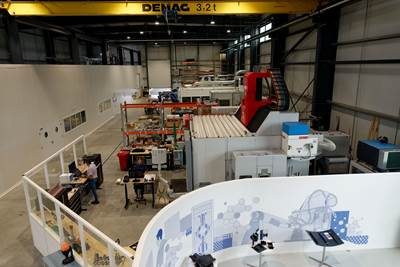World's first glass fiber leaf spring for 40-ton trucks
IFC Composites moves beyond its light truck composite leaf springs for Daimler, developing a heavy commercial truck version that cuts 400 kg vs. steel.
IFC Composites (Haldensleben, Germany) has developed a leaf spring made from fiber reinforced composite for 40-ton trucks which it displayed in 2014 at the 65th IAA for Commercial Vehicles (Sep. 25-Oct. 2, Hannover, Germany). Announcing that this development is ready for serial production, IFC's development manager Matthias Voigt commented, "In recent months, the development progress was enormous. We have made a breakthrough and are confident to bring our fiberglass leaf springs for the truck segment in series."
IFC Composite is not new to leaf springs for trucks. Indeed, it has been mass-producing glass-reinforced epoxy-based leaf springs since 2005, reportedly supplying more than 1.3 million composite leaf springs for light-duty trucks, including Daimler’s Sprinter cargo van. It also claims to have a 0% rejection rate and no customer complaints to date. Plant manager Rüdiger Trojahn adds, "Our Sprinter leaf spring is 20 kg lighter that its steel predecessor – that is an 80% weight reduction."
The focus for this heavier truck component is again weight savings, with a reported 400 kg saved compared to a steel component. IFC says this weight savings can be used in load or converted to improve fuel economy. The CO2 emissions also decrease and the vehicle benefits from the finer response and reduced tire noise.
CEO Oliver Schimpf comments, "If you want to have a 40-ton truck, prevent the roads from damage, and consume less fuel, it is impossible to avoid components made from fiber composite materials." Trojahn also touts composites' break resistance, explaining that if the material is damaged, only the top layer is frayed. He claims that steel breaks when damaged and also becomes brittle in cold regions, something that composites can be designed to resist. Composites also excel in corrosion resistance and durability, demonstrated in various marine applications and in offshore wind turbines.
Still, Schimpf acknowledges the heavy truck market will need to change. "No one pays three times the amount just because of its low weight", says Schimpf. Composites' higher material cost must be offset by more efficient structures. This is why IFC Composite develops components that integrate several functions. "Instead of springs with five leaves, ours only have one," Schimpf notes. "From a seat with 80 components, we produce one with 14." Schimpf also touts the company's experience and points out that engineers from the US, India, China and Korea have visited IFC Composites to learn more about composite leaf springs and companies are investing in development prgrams. The company has also increased production from 250,000 to one million parts per year. Schimpf says this was possible thanks to parent company IFC Rotorion, also based in Haldensleben, a 1,500-employee company that produces joints and shafts for the global automotive industry.
IFC Composites produces both glass and carbon fiber-reinforced plastics (GFRP and CFRP), used for not only leaf springs but also in shafts, stabilizers and coupling elements for wind turbines . The company's 40 employees oversee automated processes. For example, continuous fibres are drawn and impregnated with resin on a support layer. A machine stacks the strips and cuts them to length in an air-conditioned environment. Components are then created by cooling, heating, resting and pressing at several stages. Fiber alignment is tailored to meet each application's requirements.
Schimpf sees a bright future for the company, especially if it can get its composite leaf springs into further mass production. "We had five million euros in turnover in 2013. We can most likely quadruple this by 2018."
Related Content
Combining multifunctional thermoplastic composites, additive manufacturing for next-gen airframe structures
The DOMMINIO project combines AFP with 3D printed gyroid cores, embedded SHM sensors and smart materials for induction-driven disassembly of parts at end of life.
Read MoreThe potential for thermoplastic composite nacelles
Collins Aerospace draws on global team, decades of experience to demonstrate large, curved AFP and welded structures for the next generation of aircraft.
Read MorePlant tour: Collins Aerospace, Riverside, Calif., U.S. and Almere, Netherlands
Composite Tier 1’s long history, acquisition of stamped parts pioneer Dutch Thermoplastic Components, advances roadmap for growth in thermoplastic composite parts.
Read MoreBladder-assisted compression molding derivative produces complex, autoclave-quality automotive parts
HP Composites’ AirPower technology enables high-rate CFRP roof production with 50% energy savings for the Maserati MC20.
Read MoreRead Next
All-recycled, needle-punched nonwoven CFRP slashes carbon footprint of Formula 2 seat
Dallara and Tenowo collaborate to produce a race-ready Formula 2 seat using recycled carbon fiber, reducing CO2 emissions by 97.5% compared to virgin materials.
Read MorePlant tour: Daher Shap’in TechCenter and composites production plant, Saint-Aignan-de-Grandlieu, France
Co-located R&D and production advance OOA thermosets, thermoplastics, welding, recycling and digital technologies for faster processing and certification of lighter, more sustainable composites.
Read More









